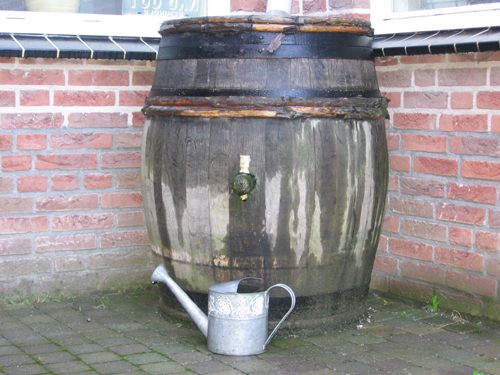
 Collecting rainwater, or rain harvesting, to use on your plants is a great idea, so long as it's legal in your area.
Collecting rainwater, or rain harvesting, to use on your plants is a great idea, so long as it's legal in your area.
Basically, with a few modifications any heavy barrel container, also called a rain barrel, that won’t let in light can be used to collect roof runoff from a downspout.
If you don’t want to make your own, there are many rain barrels available commercially.
Rain Harvesting: How Much to Collect
Whether you buy or build a barrel for rain harvesting, you will not want to collect more water than you will use in a week to water your ornamental plants and/or lawn.
You can also use the harvested water to wash your shovels and other garden tools.
Rain Harvesting: Safety Concerns
There are a few safety concerns to keep in mind, because of bacteria and chemicals water collected from roof downspouts should not be used on vegetables or as drinking water for humans.
Be careful about the type of roofing materials that are on your house. Runoff water from roofs having tar and gravel including asphalt shingles, made of asbestos or treated cedar shingles should not retained in a rain barrel to be used on vegetables intended for human consumption.
You will want to make sure your rain barrel empties out once a week so you do not have issues with mosquitoes and algae.
If you live where it freezes during the winter months, it will also be necessary to disconnect and clean your barrel for winter storage.
Make sure your barrel has an overflow spigot with a hose attached to keep water away from your foundation. If you are being chemical conscious, remember that many hoses may contain lead so make sure you use one that is lead free if that is a concern.
Make Your Own Rain Barrel for Rain Harvesting
To make your own rain barrel, you will need a barrel with a hole in the top to catch water. You will want to have the hole covered with a mesh screen to keep debris such as leaves and insects that would decompose out of your water.
Decomposing organic materials could also clog your spigots and hoses so make sure to keep your screens clean of debris buildup. There will need to be a hole toward the bottom with a spigot so you can get out water and the above mentioned overflow drainage facing away from your house.
Give Rain Harvesting a Try
Using a rain barrel will reduce runoff contamination from pesticides and fertilizers. It will also keep water away from your foundation. If you have to pay for water where you live it will also save you money.
With so many benefits for such a small amount of trouble why not give it a try?
Learn more from the author about self-sufficient homesteads in her Living Ready University Online Course, Food Preservation & Garden Planning.









